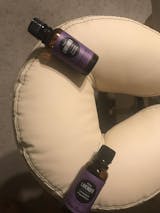Free shipping on all orders in the US!
Embrace the elegance and purity of Edens Garden's Fine Lavender essential oil, often hailed as the "mother of essential oils" for its versatile and powerful properties. Sourced from the picturesque fields of France, this essential oil is a testament to luxury and effectiveness. With its distinctive floral, light, and sweet aroma, Fine Lavender not only soothes the senses but also offers a bouquet of anti-inflammatory and antimicrobial benefits. It’s not simply an oil; it's an indulgence that pampers your skin and spirit alike.
Applying this French-grown Lavender topically is like bestowing your skin with nature's own anti-aging elixir. Imagine reducing the appearance of fine lines and unveiling a brighter complexion with just a few drops—this is the allure of Fine Lavender's exquisite composition. Moreover, in the world of aromatherapy, its swift soothing effect on frazzled nerves is unrivaled. Picture yourself unwinding after a long day, the gentle aroma of Fine Lavender lifting the weight of the world off your shoulders. These are the moments our customers treasure and share, and they could be yours too.
Incorporating Fine Lavender essential oil into your daily life is refreshingly simple. Start by mixing a drop into your evening moisturizer, transforming routine skincare into a rejuvenating ritual. Or craft your own serene atmosphere by adding a few drops to a diffuser, instantly creating a calming sanctuary in your home. For those new to essential oils, let Edens Garden guide you to a more natural and holistic way of living. Take the step towards self-care infused with the grace of French Lavender, and let nature's tender touch heal and harmonize your life.
Botanical Name: Lavandula angustifolia
Type: Fine
Origin: France
Method: Steam Distilled
Plant Part: Flowers
Note: Middle
Family: Lamiaceae
Blends Well With: Citruses, florals, woods and herbs. Lavender blends well with almost any oil
Aroma: Sweet, fresh, floral with a dry herbaceousness and undeniably Lavender aroma
Consistency: Thin
Color: Clear
Safety: Keep out of reach of children. If pregnant or under a doctor’s care, consult physician. Avoid contact with eyes. Do not use internally unless instructed by a licensed aromatherapist or physician.
OK For Kids: 2+
Kids Max Dilution: 1%
Shelf Life: 4 Years
Pet Safety: Essential oils are generally safe to diffuse around adult cats and dogs intermittently. Ensure the room you’re diffusing in is well-ventilated and that your pet can leave if desired. Discontinue use if you notice any adverse reaction. Avoid topical use and diffusing around young pets, small animals or pets with health problems.
- Lavender essential oil is made via steam distillation. In aromatherapy steam distillation, plant material is placed in a still, water is added, then heat is applied to the unit. As water heats, plants release their essential oil, the oil rises with steam droplets that are sucked into a pipe and the oil and water are then separated. While it may not be possible to make Lavender essential oil at home without a still, you can make aromatic hydrosol water that contains many of the same therapeutic benefits as the essential oil. Click here for instructions on how to make your own hydrosol.
- Lavender essential oil is known for its relaxant properties that help to calm the central nervous system, reduce irritability and nervousness as well as relieve stress and anxiety and even ease a headache. Due to this, its ability to usher in quiet sleep is well known. However, some essential oils work better in tandem with other calming and sedating essential oils. Lavender has been the subject of numerous studies and it has been shown to improve people achieve slow wave or deep sleep for longer periods. What's great is that Lavender is a safe oil for adults and children alike.
- Lavender essential oil contains a compound known as linalool which has a strong floral odor that is pleasant to humans and detestable to mosquitos. The aroma overloads the sensitive olfactory organs of mosquitoes in the same manner as DEET. To increase the effectiveness of Lavenders' repellant abilities, consider blending it with other oils such as Citronella, Eucalyptus- Lemon and Catnip and always dilute with a carrier oil such as coconut oil for topical body care applications.
- Essential oils are powerful, concentrated substances so a little goes a long way. Two of the most effective ways to use them is by way of inhalation and topical use. Ingesting Lavender essential oil is rarely necessary or recommended, no matter the brand. Essential oil ingestion can lead to adverse reactions such as medication contraindications, mucous membrane irritation, sensitization and nausea if done incorrectly. Therefore, if you wish to eat essential oils, we strongly recommend consulting with a knowledgeable professional with experience in internal use.
- Fine lavender made from Lavandula angustifolia is grown at a higher altitude giving it a slightly sharper and stronger aromatic than Bulgarian or French Lavender. The higher altitude changes the chemical make up of the oil ever so slightly making its linalool and linalyl acetate content is almost equal compared to Lavender grown at lower altitudes. Just as with Bulgarian, Greek or French Lavender, however, Fine Lavender is as well-known for its anti-inflammatory, antimicrobial and skin-loving properties.

Apply Topically: Our Single Essential Oils and Synergy Blends are 100% pure and undiluted. To apply to the skin, dilute with a high-quality Carrier Oil. See our dilution chart here. We recommend performing a skin patch test when using a new essential oil topically.
Diffuse & Inhale: Breathe in your favorite essential oils using an essential oil diffuser or personal pocket inhaler. For instructions on how to use your diffuser, please refer to the diffuser's product page.
DIYs: Explore simple and fun recipes on The Drop, our essential oil blog with expert tips, EO news, and informative reads.
